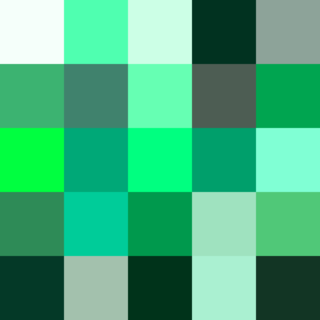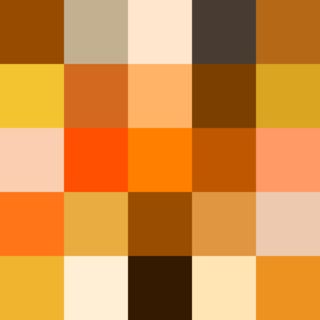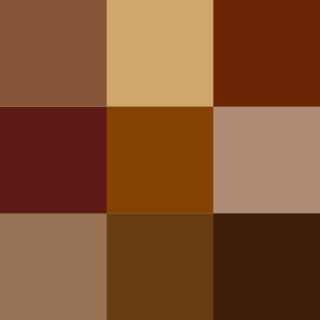
The national flag of the Philippines is a horizontal bicolor flag with equal bands of royal blue and crimson red, with a white, equilateral triangle at the hoist. In the center of the triangle is a golden-yellow sun with eight primary rays, each representing a province. At each vertex of the triangle is a five-pointed, golden-yellow star, each of which representing one of the country's three main island groups—Luzon, the Visayas and Mindanao. The white triangle at the flag represents liberty, equality, and fraternity. A unique feature of this flag is its usage to indicate a state of war if it is displayed with the red side on top, which is effectively achieved by flipping the flag upside-down.

Gold, also called golden, is a color.

School colors are the colors chosen by a school to represent it on uniforms and other items of identification. Most schools have two colors, which are usually chosen to avoid conflicts with other schools with which the school competes in sports and other activities. The colors are often worn to build morale among the teachers and pupils, and as an expression of school spirit.

Teal is a cyan-green color. Its name comes from that of a bird — the Eurasian teal — which presents a similarly colored stripe on its head. The word is often used colloquially to refer to shades of cyan in general.

Maroon is a brownish crimson color that takes its name from the French word marron, or chestnut. "Marron" is also one of the French translations for "brown".
In many languages, the colors described in English as "blue" and "green" are colexified, i.e. expressed using a single cover term. To describe this English lexical gap, linguists use the portmanteau word grue, from green and blue, a term coined by the philosopher Nelson Goodman—with a rather different meaning—in his 1955 Fact, Fiction, and Forecast to illustrate his "new riddle of induction".

Midnight blue is a dark shade of blue named for its resemblance to the apparently blue color of a moonlit night sky around full moon. Midnight blue is the color of a vat full of indigo dye; therefore, midnight blue may also be considered a dark shade of indigo. Midnight blue is identifiably blue to the eye in sunlight or full-spectrum light, but can appear black under certain more limited spectra sometimes found in artificial lighting. It is similar to navy, which is also a dark blue.

Spring green is a color that was traditionally considered to be on the yellow side of green, but in modern computer systems based on the RGB color model is halfway between cyan and green on the color wheel.
Royal blue is a deep and vivid shade of blue. It is said to have been created by clothiers in Rode, Somerset, a consortium of whom won a competition to make a dress for Queen Charlotte, consort of King George III.

Blue-green is a representation of the color that is between green and blue on a typical traditional RYB color wheel. It belongs to the cyan family of colors.

The Google logo appears in numerous settings to identify the search engine company. Google has used several logos over its history, with the first logo created by Sergey Brin using GIMP. A revised logo debuted on September 1, 2015. The previous logo, with slight modifications between 1999 and 2013, was designed by Ruth Kedar, with a wordmark based on the Catull, an old style serif typeface designed by Gustav Jaeger for the Berthold Type Foundry in 1982.

In optics, orange has a wavelength between approximately 585 and 620 nm and a hue of 30° in HSV color space. In the RGB color space it is a secondary color numerically halfway between gamma-compressed red and yellow, as can be seen in the RGB color wheel. The complementary color of orange is azure. Orange pigments are largely in the ochre or cadmium families, and absorb mostly blue light.

Yale Blue is the dark azure color used in association with Yale University.

Varieties of the color green may differ in hue, chroma or lightness, or in two or three of these qualities. Variations in value are also called tints and shades, a tint being a green or other hue mixed with white, a shade being mixed with black. A large selection of these various colors is shown below.

Varieties of the color blue may differ in hue, chroma, or lightness, or in two or three of these qualities. Variations in value are also called tints and shades, a tint being a blue or other hue mixed with white, a shade being mixed with black. A large selection of these colors is shown below.

Variations of gray or grey include achromatic grayscale shades, which lie exactly between white and black, and nearby colors with low colorfulness. A selection of a number of these various colors is shown below.

The color cyan, a greenish-blue, has notable tints and shades. It is one of the subtractive primary colors along with magenta, and yellow.

Shades of brown can be produced by combining red, yellow, and black pigments, or by a combination of orange and black—as can be seen in the color box at right. In the RGB color model used to create all the colors on computer and television screens, brown is made by combining red and green light at different intensities. Brown color names are often not very precise, and some shades, such as beige, can refer to lighter shades of yellow and red rather than darker ones. The commonality is that such colors are less saturated than colors perceived to be orange. Browns are usually described as light or dark, reddish, yellowish, or gray-brown. There are no standardized names for shades of brown; the same shade may have different names on different color lists, and sometimes the one name can refer to several very different colors. The X11 color list of web colors lists seventeen different shades of brown, but the complete list of browns is much longer.

Shades of black are colors that differ only slightly from pure black. These colors have a low lightness. From a photometric point of view, a color which differs slightly from black always has low relative luminance. Variations of black include what are commonly termed off-black colors, which may be considered part of a neutral color scheme, usually in interior design as a part of a background for brighter colors. Black and dark gray colors are powerful accent colors that suggest weight, dignity, formality, and solemnity.

Azure is a variation of blue that is often described as the color of the sky on a clear day.










